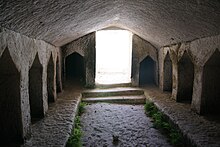Kokh
A kokh (plural: kokhim, Hebrew: כּוּךְ; Aramaic : "oven") is a burial system characterized by a series of narrow burial chambers that extend radially from a central chamber, which are usually carved into the rock and closed with a stone slab has been. This corresponds to the Hebrew term loculus . Kokhim are Middle Eastern graves; in Israel they originate from the time of the second temple (about 515 v. Chr.) The use of the term's rabbinic literature frequently and 1932 of Eleasar Sukenik (1889-1953) in a Aramaic inscription in a grave in Kidron Valley discovered .
A kokh is about 2 m long and 50 cm wide. Its size varies from one grave to another. The locking plate is designed to be opened several times. Several Kokhim still sealed have been discovered during excavations. Kokhim have small channels that lead into the central chamber to drain water that has seeped through the rock.
A Kokhim is located at the western end of the Church of the Holy Sepulcher in Jerusalem . The church wall runs through the center of the complex, which is partially destroyed as a result. Other Kokhim are located in the foothills of the Judean Mountains , but also in Petra .
literature
- Amos Kloner, Boaz Zissu : The Necropolis of Jerusalem in the Second Temple Period , Louvain, Peeters, 2007 ISBN 978-90-429-1792-7

